Introduction

3D NAND technology was invented by Toshiba, and is being adopted by all flash manufacturers. Samsung is first to the market with a consumer-based 3D NAND based product. That product is what you see here today, the Samsung 850 Pro. Planar, or 2D NAND, is rapidly closing in on the limits of lithography shrinkage, necessitating a new path to increasing capacity while lowering production costs by increasing yield. 3D NAND technology is that path.
Samsung calls their 3D NAND technology V-NAND, or Vertical NAND. By stacking cells vertically, Samsung is able to increase capacity 100x in only one-tenth the same area. This vertical stacking allows density on die increases without shrinking lithography. The main problem with shrinking lithography below 30nm is cell-to-cell interference. Cell-to-cell interference causes data corruption, and increases the need for a powerful error correction engine, and the overhead that comes with it.
Samsung's V-NAND technology is based on 30nm lithography with 32 layers stacked vertically. Because Samsung is able to utilize a 30nm process and get more density than planar NAND at much smaller lithography's, cell-to-cell interference is greatly reduced, while the die's density increases simultaneously. A 30nm process means the V-NAND inherently has about 10x the endurance of planar NAND at a 16nm process, and less errors to correct means greatly reduced power consumption.
In the near future, all NAND will be 3D based, but if you want a 3D NAND based SSD right now, Samsung is the only game in town. The 850 Pro has been out for a while, so it's not news to most of you that it is considered one of the fastest SSD's available on the market today - we already know this. However, we are left with a burning question: What about RAID? As we have repeatedly seen, the fastest single drive does not always make for the fastest array; in fact, it has never even happened.
As we look around the net, we have seen more and more futile attempts by other review sites to run RAID 0. Apparently, no one but TweakTown even has a clue how to properly run RAID 0. We know what driver to use, and how to properly configure our arrays - two critical elements that continue to elude the competition. Fortunately, TweakTown has a step-by-step guide available (by clicking HERE) that will show you how to properly configure your array.
The only reason I mentioned this is because we are seeing other review sites posting pitiful RAID 0 results that are very misleading. I have even seen some reviewers say that PCIe Drives like G.Skill's Phoenix Blade are faster than any Intel RST SATA based array, which could not be further from the truth, provided your array is properly configured. Remember, a properly configured array has up to 10x lower QD1 write latency when IRST write-back caching is enabled.
Today we are going to see if our three-drive 850 Pro array has what it takes to become our new RAID 0 champion.
PRICING: You can find Samsung's 850 Pro (256GB) SSD for sale below. The prices listed are valid at the time of writing, but can change at any time. Click the link to see the very latest pricing for the best deal.
United States: The Samsungs 850 Pro (256GB) retails for $180.40 at Amazon USA.
Canada: The Samsungs 850 Pro (256GB) retails for $199.00 at Amazon Canada.
Specifications, Drive Details, Test System Setup, Drive Properties, Pricing, and Availability
Specifications
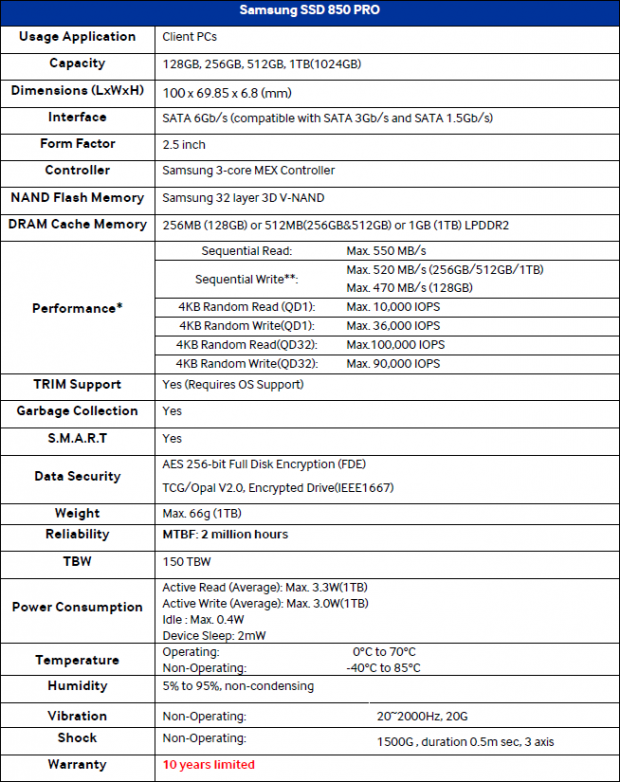
Samsung's 850 Pro SATA III SSD is available in four capacities, 128GB, 256GB, 512GB, and 1TB. Specifications list the 256GB 850 Pro SSD as capable of 550MB/s sequential reads, and 520MB/s sequential writes. Max random read/write speed is listed at 100,000/90,000 IOPS. Samsung's 850 Pro comes in a 2.5" x 7mm z-height form factor, and ships with proprietary software for drive management, and free migration software is available for download. The 850 Pro supports AES 256-bit hardware encryption that meets TCG Opal 2.0 and IEEE-1667 standards. Samsung backs the 850 Pro with an industry leading ten-year warranty with a 150 TBW (Terabytes Written) limit.
Because this is a RAID review, we are going to focus on performance rather than features. For a more in-depth look at the Samsung 850 Pro's feature set, I will refer you to Chris Ramseyer's extensive review of Samsung's 850 Pro 256GB SSD.
Drive Details - Samsung 850 Pro 256GB SSD
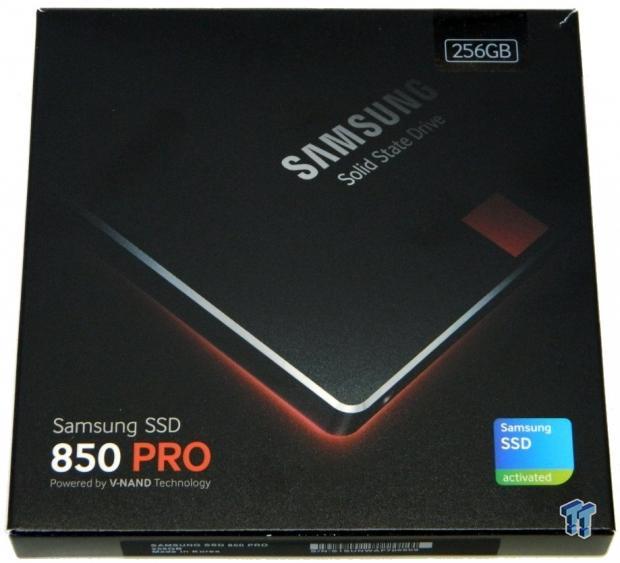
Samsung packages their 850 Pro in an attractive black box. There is a picture of the drive on the top of the box. The drive's capacity is listed on a sticker placed on the top right corner of the front of the box.
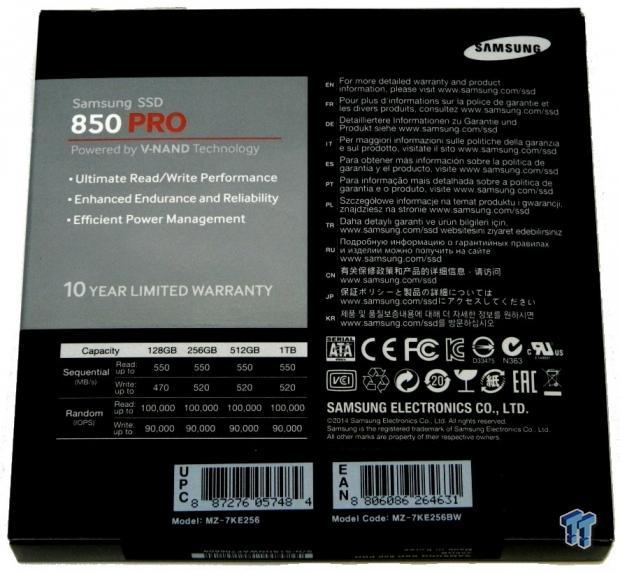
The rear of the box lists the drive's performance specifications, its ten-year limited warranty, model number, and UPC code.
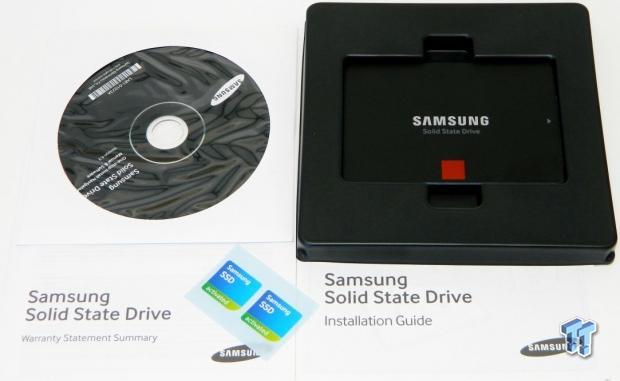
The drive comes cradled in a plastic tray for protection. A software CD, printed warranty statement, installation guide, and a pair of "Samsung SSD Activated" stickers are all included.
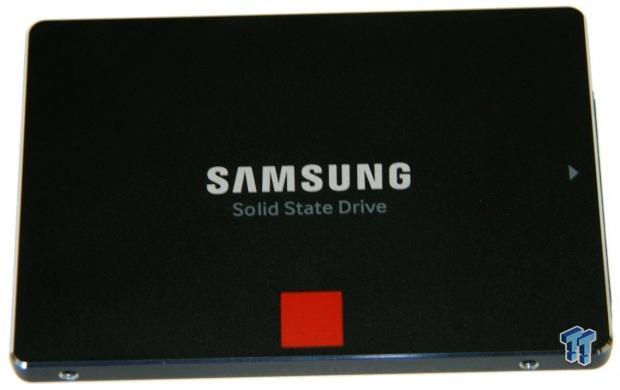
The top and sides of the 850 Pro's enclosure are formed from piece of cast, glass-beaded aluminum that has been painted black. Beveled edges and rounded corners give it a nice touch.
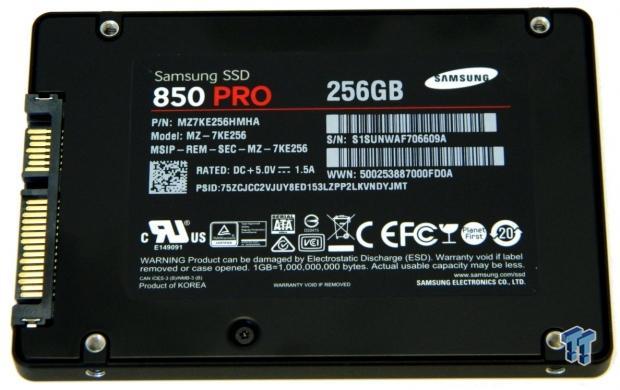
The bottom of the drive's enclosure is formed from a piece of stamped sheet aluminum painted dark gray. Centered on the rear face of the enclosure is a manufacturer's sticker that lists the drive's part number, serial number, and capacity. Three pentalobe screws, two of which are hidden by the sticker, secure the bottom of the enclosure.
Typically, we open up a drive to show you what is inside, but not this time (can't find my pentelobe driver). To view the internals of this drive, you can click HERE.
Test System Setup

- Drive Properties

The majority of our testing is performed with our test drive/array as our boot volume. Our boot volume is 75% full for all OS Disk "C" drive testing to replicate a typical consumer OS volume implementation. We are using 64k stripes for all of our three-drive arrays. Cstates and Speed stepping are both disabled in our system's BIOS, High Performance power plan is enabled in Windows, Write-back caching is enabled via Intel's RST control panel, and Windows' buffer flushing is disabled. We are utilizing Windows 8.1 64-bit for all of our testing.
Synthetic Benchmarks - ATTO, Anvil Storage Utilities, CrystalDiskMark & AS SSD
ATTO
Version and / or Patch Used: 2.47
ATTO is a timeless benchmark used to provide manufacturers with data used for marketing storage products.
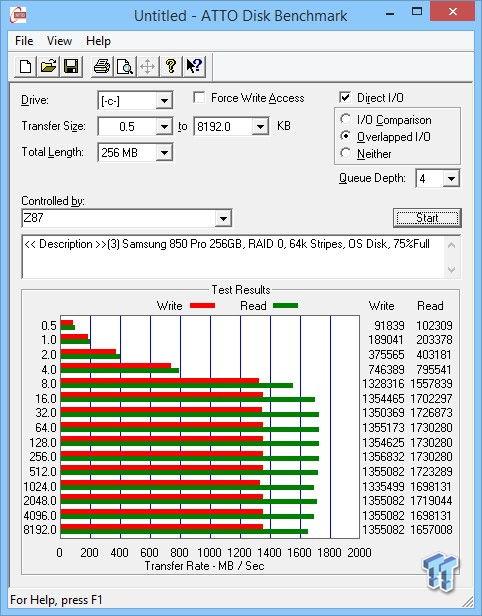
Sequential read transfers max out at 1.650 GB/s. Sequential write transfers max out at 1.293 GB/s. Overall, this is the best sequential performance we've seen from any SATA based array.
Sequential Write
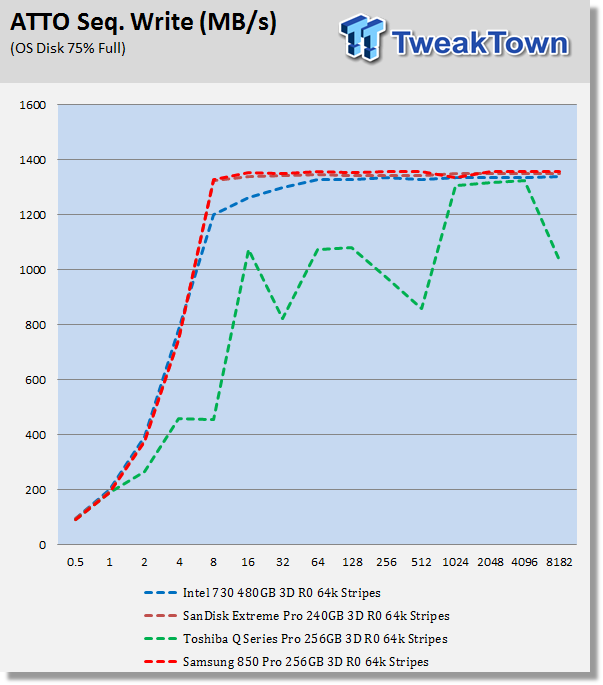
Our 850 Pro arrays' sequential write performance closely mirrors the performance of our SanDisk Extreme Pro array.
Sequential Read
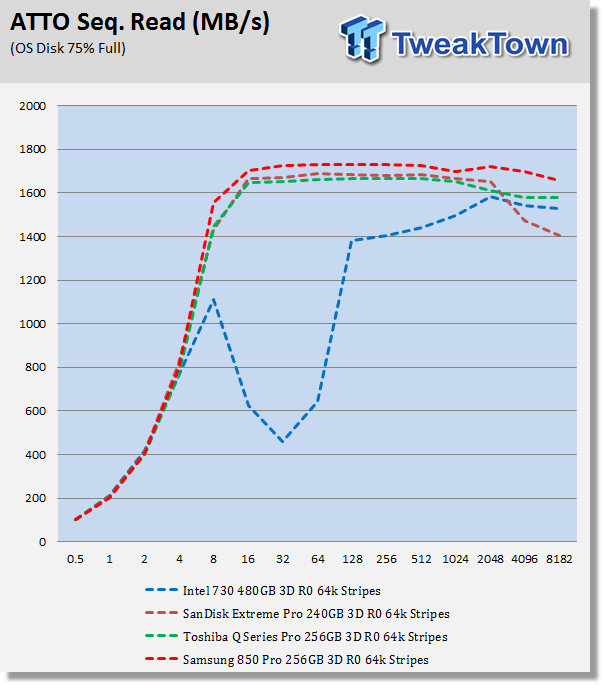
The 850 Pro really shines in Sequential Read Performance. Whether it be a single drive, or a properly configured array, Samsung's revolutionary 850 Pro has the best sequential read performance of any SATA based SSD on the market today.
Anvil Storage Utilities
Version and / or Patch Used: RC6
Anvil's Storage Utilities is a storage benchmark designed to measure the storage performance of SSDs. The Standard Storage Benchmark performs a series of tests; you can run a full test, or just the read or write test, or you can run a single test, i.e. 4k QD16.

12,000 points is a new lab record for a three-drive array running on Windows 8.1. Our 850 Pro array delivers massive performance across the board. The only PCIe drive we've had in the lab that can exceed this performance is Intel's NVMe based DC P3700 PCIe SSD, and that drive will set you back about $2500.
To illustrate just how well our 850 Pro array is performing, let's compare it to the performance of G.Skill's newly launched, highly touted Phoenix Blade PCIe drive.

There is no comparison; our 850 Pro SATA based array demolishes the Phoenix PCIe drive. Most importantly, our 850 Pro array leaves it in the dust where it matters most to your OS: random, low QD write performance. Even properly configured two-drive arrays composed of SATA based SSD's running on RST ports will leave the Phoenix Blade, or any other consumer based PCIe drive, in the dust (in an OS environment).
This comparison also serves to illustrate why, as I pointed out earlier, reviewers that have stated the Phoenix Blade, or any other consumer based PCIe drive to date, can outperform an Intel based array in an OS environment are incorrect. Reviewers can only be making that statement because they apparently do not understand how to properly configure an Intel based array, or they are simply making an uneducated assumption - an assumption that should not be past as fact to the consumer.
The performance disparity only gets worse for (non-NVMe) consumer based PCIe drives in a workload environment where read/writes are occurring concurrently, because they simply do not have good low QD random performance. In most cases, current consumer based PCIe drives cannot even outperform a single hyper-class SATA based SSD in an OS environment. If you do not believe this is a fair comparison, keep in mind that the Phoenix Blade, Revo 350, Comay Blade, etc. are essentially four SSDs in one, attached via a bus with far more bandwidth than SATA has available.
Read IOPS through Queue Depth Scale
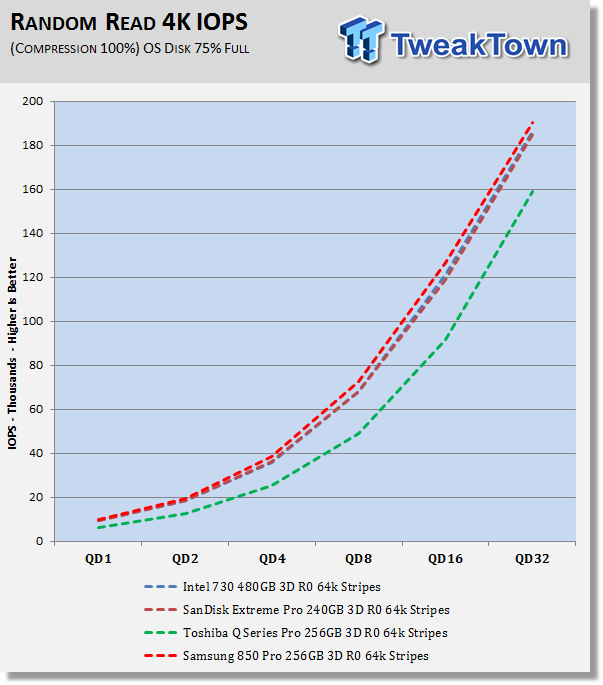
Our 850 Pro array leads the rest of our arrays at all queue depths, finishing with a whopping 190,000 IOPS at QD32.
Write IOPS through Queue Scale

Again, our 850 Pro array delivers the best performance of all the arrays on our chart, topping out at over 240,000 IOPS at QD4. Maximum write IOPS when running Windows 8.1 for all our arrays with the exception of our Toshiba Q Series Pro array is achieved at QD4. Our Q Series Pro array does not deliver good performance with most synthetic benchmarks; however, it delivers the goods in a massive way when we run workload simulations.
CrystalDiskMark
Version and / or Patch Used: 3.0 Technical Preview
CrystalDiskMark is disk benchmark software that allows us to benchmark 4k and 4k queue depths with accuracy.
Note: Crystal Disk Mark 3.0 Technical Preview was used for these tests since it offers the ability to measure native command queuing at QD4.
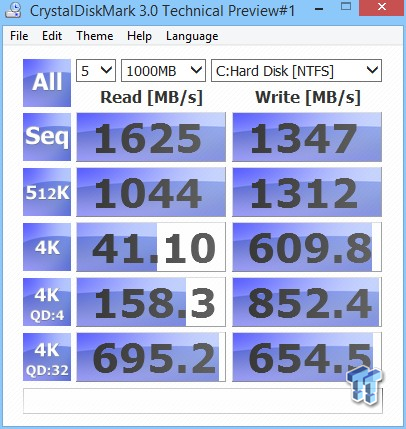
Our 850 Pro array is just destroying all of our synthetic benchmarks. This is the best overall CDM performance we've seen from any array running on Windows 8.1. Maximum random write performance is delivered at QD4, confirming what we saw with our Anvil's testing.

Breaking down read performance reveals that only our Intel 730 array can outperform our 850 Pro array in one category, QD32 read.

A write performance breakdown mirrors what we saw with read. Only our Intel 730 array is able to outperform our 850 Pro array, and that is again in a single category, QD32 write.
AS SSD
Version and / or Patch Used: 1.7.4739.38088
AS SSD determines the performance of Solid-State Drives (SSD). The tool contains four synthetic, as well as three practice tests. The synthetic tests are to determine the sequential and random read and write performance of the SSD.
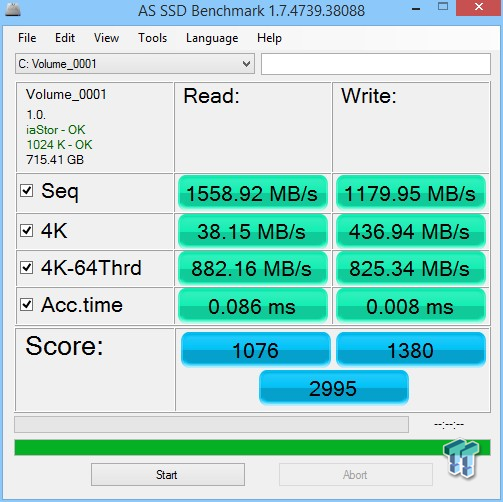
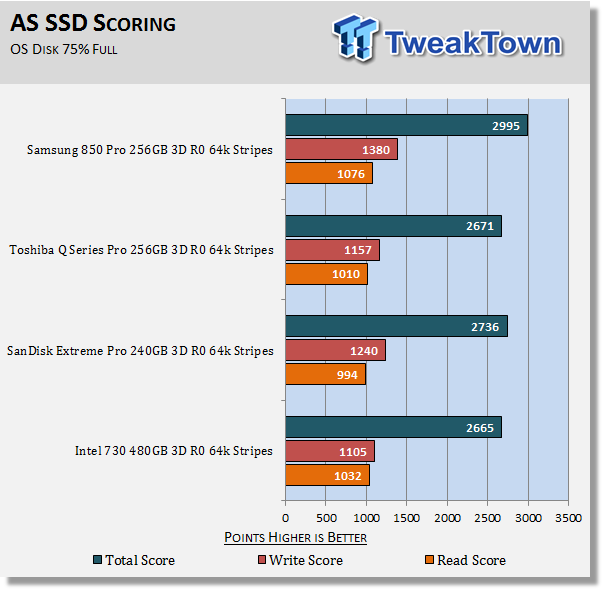
Our last synthetic based benchmark tells exactly the same story, and that is Samsung's 850 Pro is a synthetic benchmark juggernaut. So far, V-NAND has dominated our planar-based arrays. Although, many times this does not carry through when it comes to our much more important workload simulations. Let's move on to our light usage model simulations, and see what our 850 Pro array can deliver.
Benchmarks (Trace Based OS Volume) - PCMark Vantage, PCMark 7 & PCMark 8
Light Usage Model
We are going to categorize these tests as indicative of a light workload. If you utilize your computer for light workloads like browsing the web, checking emails, light gaming, and office related tasks, then this category of results is most relevant for your needs.
PCMark Vantage - Hard Disk Tests
Version and / or Patch Used: 1.2.0.0
The reason we like PCMark Vantage is because the recorded traces are played back without system stops. What we see is the raw performance of the drive. This allows us to see a marked difference between scoring that other trace-based benchmarks do not exhibit. An example of a marked difference in scoring on the same drive would be empty vs. filled vs. steady state.
We run Vantage three ways. The first run is with the OS drive/Array 75% full to simulate a lightly used OS volume filled with data to an amount we feel is common for most users. The second run is with the OS volume written into a "Steady State," utilizing SNIA's guidelines (Rev 1.1). Steady state testing simulates a drive/array's performance similar to that of a drive/array that has been subjected to consumer workloads for extensive amounts of time. The third run is a Vantage HDD test with the test drive/array attached as an empty, lightly used, secondary device.
OS Volume 75% Full - Lightly Used

OS Volume 75% Full - Steady State

Secondary Volume Empty - Lightly Used
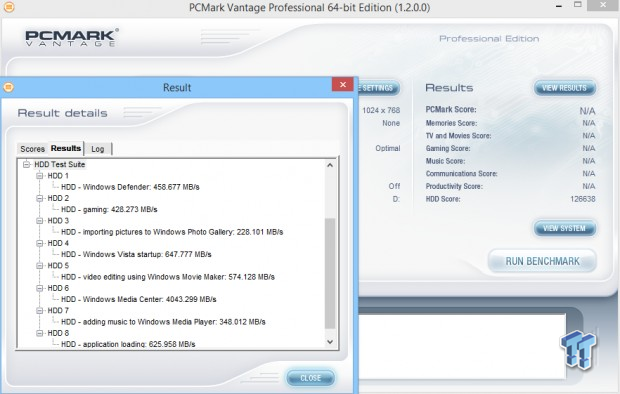
As you can see, there's a big difference between an empty drive/array, one that's 75% full/used, and one that's in a steady state.

The important scores to pay attention to are "OS Volume Steady State," and "OS Volume 75% full." These two categories are most important because they are indicative of typical of consumer user states.
When a drive/array is in a steady state, it means garbage collection is running at the same time it's reading/writing. This is exactly why we focus on steady state performance. Again, our 850 Pro array is able to outperform the competition, delivering massive light usage model steady state performance. Here is where we begin to see that Toshiba's Q Series Pro is a force to be reckoned with. Despite its sub-par synthetic performance, our Q Series Pro array delivers where it really matters, in an OS based workload scenario.
PCMark 7 - System Storage
Version and / or Patch Used: 1.4.00
We will look to the Raw System Storage scoring for RAID 0 evaluations because it's done without system stops, and therefore allows us to see significant scoring differences between drives/arrays.
OS Volume 75% Full - Lightly Used


For the first time, our 850 Pro array does not dispatch the competition, and comes in third place.
PCMark 8 - Storage Bandwidth
Version and / or Patch Used: 1.2.157
We use the PCMark 8 Storage benchmark to test the performance of SSDs, HDDs, and hybrid drives with traces recorded from Adobe Creative Suite, Microsoft Office, and a selection of popular games. You can test the system drive, or any other recognized storage device, including local external drives. Unlike synthetic storage tests, the PCMark 8 Storage benchmark highlights real-world performance differences between storage devices.
OS Volume 75% Full - Lightly Used


PCMark 8 is the most intensive workload simulation we run, and our 850 Pro array does not do well with this testing. Our Intel 730 array shows us why it is our current RAID champion. Our Q Series Pro array also displays its incredible prowess when it comes to running random mixed workloads.
Benchmarks (Secondary Volume) - Disk Response & Transfer Rates
Iometer - Disk Response
Version and / or Patch Used: 1.1.0
We use Iometer to measure disk response times. Disk response times are measured at an industry accepted standard of 4k QD1 for both write and read. Each test runs twice for 30 seconds consecutively, with a five second ramp-up before each test. The drive/array is partitioned and attached as a secondary device for this testing.
Write Response

Read Response

Average Disk Response
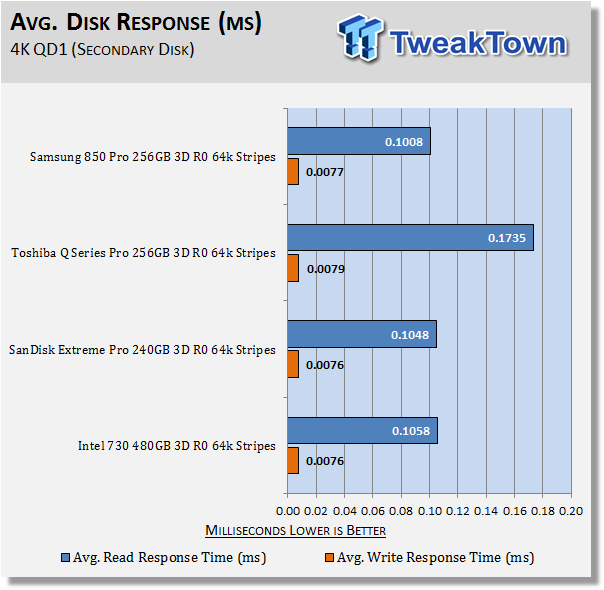
Write response times benefit most from RAID 0 because of write caching. There is a slight latency increase in read response times for an array vs. a single drive. Read response is the best we've seen to date from a SATA based array. Write response is also excellent; although, our 730 Pro array and our Extreme Pro array are slightly lower.
DiskBench - Directory Copy
Version and / or Patch Used: 2.6.2.0
We use DiskBench to time a 28.6GB block (9,882 files in 1,247 folders) of mostly incompressible random data as it's transferred from our DC P3700 PCIe NVME SSD to our test drive/array. We then read from a 6GB zip file that's part of our 28.6GB data block to determine the test drive/array's read transfer rate. The system is restarted prior to the read test to clear any cached data, ensuring an accurate test result.
Write Transfer Rate

Read Transfer Rate


Our 850 pro array is able to deliver yet another lab record with read transfers. Write transfer speed is also impressive, with our 850 Pro array nipping at the heels of our Extreme Pro array.
Benchmarks (Secondary Volume) - PCMark 8 Extended
Futuremark PCMark 8 Extended - Consistency Test
Heavy Usage Model
We consider PCMark 8's consistency test to be our heavy usage model test. This is the usage model most enthusiasts, heavy duty gamers, and professionals fall into. If you do a lot of gaming, audio/video processing, rendering, or have workloads of this nature, then this test will be most relevant to you.
PCMark 8 has built-in, command line executed storage testing. The PCMark 8 Consistency test measures the performance consistency, and the degradation tendency of a storage system.
The Storage test workloads are repeated. Between each repetition, the storage system is bombarded with a usage that causes degraded drive performance. In the first part of the test, the cycle continues until a steady degraded level of performance has been reached. (Steady State)
In the second part, the recovery of the system is tested by allowing the system to idle, and measuring the performance with long intervals. (TRIM)
The test reports the performance level at the start, the degraded steady-state, and the recovered state, as well as the number of iterations required to reach the degraded state and the recovered state.
We feel Futuremark's Consistency Test is the best test ever devised to show the true performance of solid state storage in a heavy usage scenario. This test takes an average of 13 to 17 hours to complete, and it writes somewhere between 450GB and 14,000GB of test data, depending on the drive/array being tested. If you want to know what a SSD's performance is going to look like after a few months or years of heavy usage, this test will show you.
Here's a breakdown of Futuremark's Consistency Test:
Precondition phase:
1. Write to the drive sequentially through up to the reported capacity with random data.
2. Write the drive through a second time (to take care of overprovisioning).
Degradation phase:
1. Run writes of random size between 8*512 and 2048*512 bytes on random offsets for ten minutes.
2. Run performance test (one pass only).
3. Repeat one and two, eight times, and on each pass, increase the duration of random writes by five minutes.
Steady state phase:
1. Run writes of random size between 8*512 and 2048*512 bytes on random offsets for 50 minutes.
2. Run performance test (one pass only).
3. Repeat one and two, five times.
Recovery phase:
1. Idle for five minutes.
2. Run performance test (one pass only).
3. Repeat one and two, five times.
Storage Bandwidth
PCMark 8's Consistency test provides a ton of data output that we can use to judge a drive/array's performance.
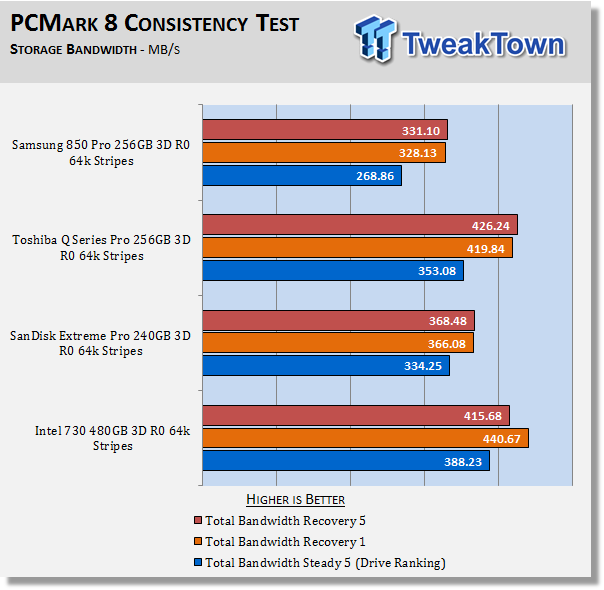
We consider steady state bandwidth (the blue bar) to be our test that carries the most weight in ranking a drive/array's performance. The reason we consider steady state performance more important than TRIM is that when you are running a heavy-duty workload, TRIM will not be occurring while that workload is being executed. TRIM performance (the orange and red bars) is what we consider the second most important aspect when ranking a drive/array's performance. Trace based consistency testing is where true high performing SSDs are separated from the rest of the pack.
Even though our 850 Pro array was able to dominate our synthetic testing by easily winning every test, quite the opposite occurred when we moved to real-world simulations. In this, our most important test, our 850 Pro array was unable to keep pace with our top arrays.
We have seen this before, so it's not really much of a surprise. Granted, this result is better than all but one consumer based PCIe SSD (Samsung's XP941 m.2 drive) running on the AHCI protocol, but in the end, it's somewhat disappointing. The 850 Pro in RAID 0 does not like the incompressible mixed random workloads that this testing simulates, and that's our measure of true performance.
We were hoping to see a new RAID champion crowned today, but that's just not in the cards for the 850 Pro.

We chart our test subject's storage bandwidth as reported at each of the test's 18 trace iterations. This gives us a good visual perspective of how our test subjects perform as testing progresses.
Total Access Time (Latency)
We chart the total time the disk is accessed as reported at each of the test's 18 trace iterations.

Disk Busy Time
Disk Busy Time is how long the disk is busy working. We chart the total time the disk is working as reported at each of the tests 18 trace iterations.

When latency is low, disk busy time is low as well.
Data Written
We measure the total amount of random data that the drive/arrays are capable of writing during the degradation phases of the consistency test. The total combined time that degradation data is written to the drive/array is 470 minutes. This can be very telling. The better the drive/array can process a continuous stream of random data, the more data will be written.
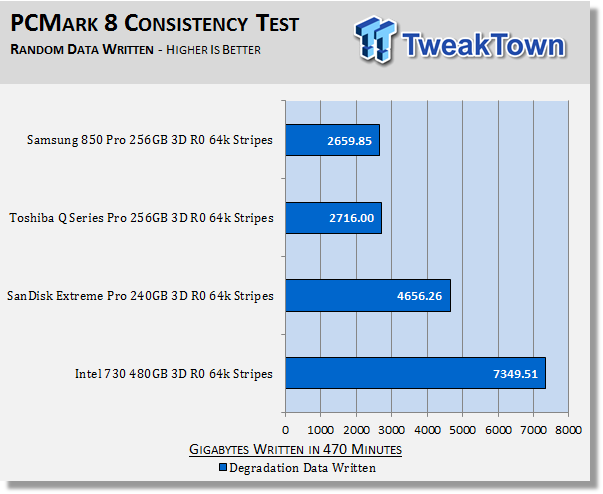
Workload latency is a problem for the 850 Pro in RAID 0, and this chart serves to illustrate that point.
Gratuitous Benchmarking
This is where we show you what our array's performance looks like when powered by the fastest operating system for SATA based storage ever made, Windows Server 2008. This is the exact same hardware, just an OS change.
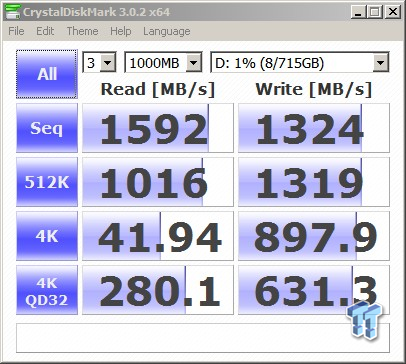



Massive synthetic performance is exhibited with nearly 900MB/s 4K QD1 write performance in CDM, which is definitely a lab record.
You can't get performance like this from Windows 8 or 8.1; you can get very close with Windows 7, or Server 2012, but nothing performs quite as well as Server 2008 when it comes to SATA based storage. 4K write performance is vastly superior on Server 2008 and Windows 7 in comparison to Windows 8 or 8.1.
Final Thoughts

Solid state storage is the most important performance component found in a modern system today. Without it, you do not even have a performance system.
Samsung is known for being first to the market with new technology. 3D NAND technology is the wave of the future, and is probably the final nail in the coffin of spinning rust buckets. Samsung's V-NAND technology is a giant step forward in the world of flash-based storage, and Samsung should be applauded for their recently launched 850 Pro.
AHCI protocol does not fully exploit the potential of Samsung's V-NAND technology, and while our 850 Pro array dominates synthetic testing, it does not follow all the way through where it needs to be. If you want to have the fastest storage solution in an operating system environment, you need to be running a properly configured RAID 0 array.
This run through the lab shows that Samsung has some work to do in the RAID 0 department. Drives like Intel's 730, our current RAID 0 champion, have been designed specifically with RAID 0 in mind, and drives like Toshiba's Q Series Pro are just inherently great performers in RAID 0. Unfortunately, this is where we find an 850 Pro array lacking.
All of this will be a moot point when can have bootable PCIe, NVMe based arrays. I anticipate that Samsung's V-NAND technology, when accessed through the NVMe protocol, will be on the leading edge of the performance curve. Until then, a Samsung's 850 Pro based array is still a great choice, and an array I can recommend you own; it's just not the fastest thing going at the moment.
RAIDing two or more drives together provides you with storage that takes performance to the next level, and is something I recommend you try. Think of it as the SLI of storage. Once you go RAID, there's no going back!
PRICING: You can find Samsung's 850 Pro (256GB) SSD for sale below. The prices listed are valid at the time of writing, but can change at any time. Click the link to see the very latest pricing for the best deal.
United States: The Samsungs 850 Pro (256GB) retails for $180.40 at Amazon USA.
Canada: The Samsungs 850 Pro (256GB) retails for $199.00 at Amazon Canada.


 United
States: Find other tech and computer products like this
over at
United
States: Find other tech and computer products like this
over at  United
Kingdom: Find other tech and computer products like this
over at
United
Kingdom: Find other tech and computer products like this
over at  Australia:
Find other tech and computer products like this over at
Australia:
Find other tech and computer products like this over at  Canada:
Find other tech and computer products like this over at
Canada:
Find other tech and computer products like this over at  Deutschland:
Finde andere Technik- und Computerprodukte wie dieses auf
Deutschland:
Finde andere Technik- und Computerprodukte wie dieses auf